Abstract
1. We have examined whether three natural tachykinins, substance P (SP), neurokinin A (NKA) and neurokinin B (NKB) induce an endothelium-dependent contraction (EDC) in the rabbit isolated intrapulmonary artery. 2. Removal of the endothelium almost abolished the contraction induced by SP (10(-8) M) while it did not attenuate the contraction induced by SP (10(-7) M), NKA (10(-9) - 10(-7) M) or NKB (10(-8) and 10(-7) M). 3. The EDC induced by SP (10(-8) M) was abolished by NK1 antagonists (FK-888, CP-96345, CP-99994 and SR-140333) but not by an NK2 antagonist (SR-48968). 4. The EDC induced by SP was attenuated by cyclo-oxygenase inhibitors (aspirin and indomethacin), thromboxane A2 (TXA2) synthetase inhibitors (OKY-046, KY-234 and KY-063) and a TXA2 antagonist (S-1452). 5. The rank order of potency causing endothelium-independent contraction (EIC) was NKA > NKB > SP. The EIC induced by SP (10(-7) M) was attenuated by an NK2 antagonist but not by NK1 antagonists, cyclo-oxygenase inhibitors, TXA2 synthetase inhibitors or a TXA2 antagonist. 6. In conclusion, SP at 10(-8) M induces EDC via endothelial NK1 receptors and TXA2 production, and SP at 10(-7) M induces EIC via NK2 receptors in the rabbit intrapulmonary artery.
Full text
PDF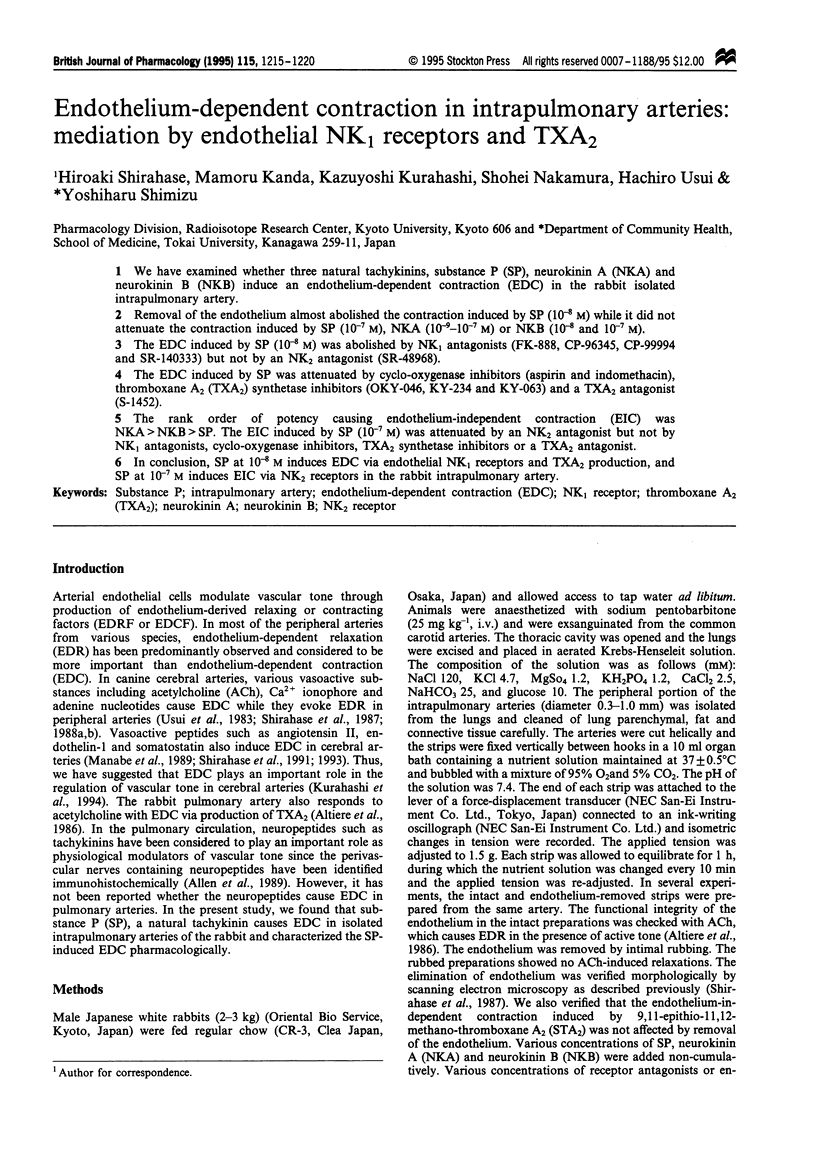
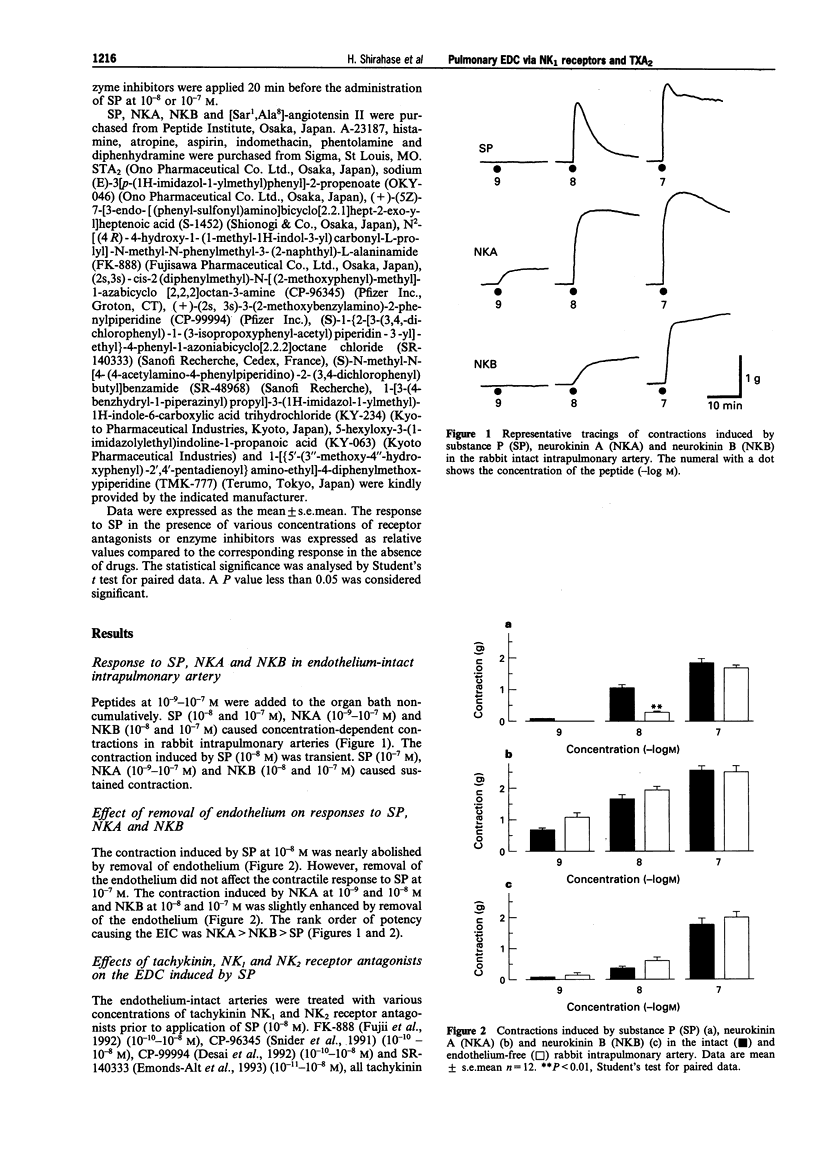
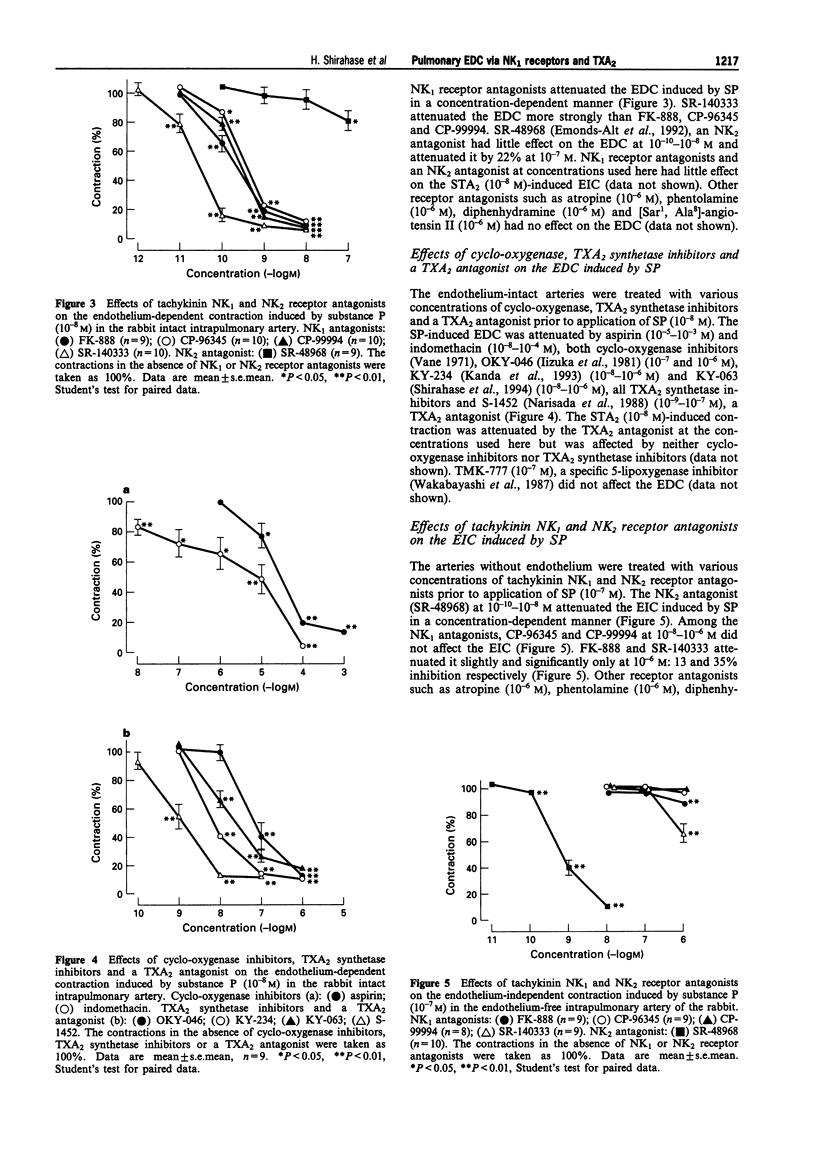
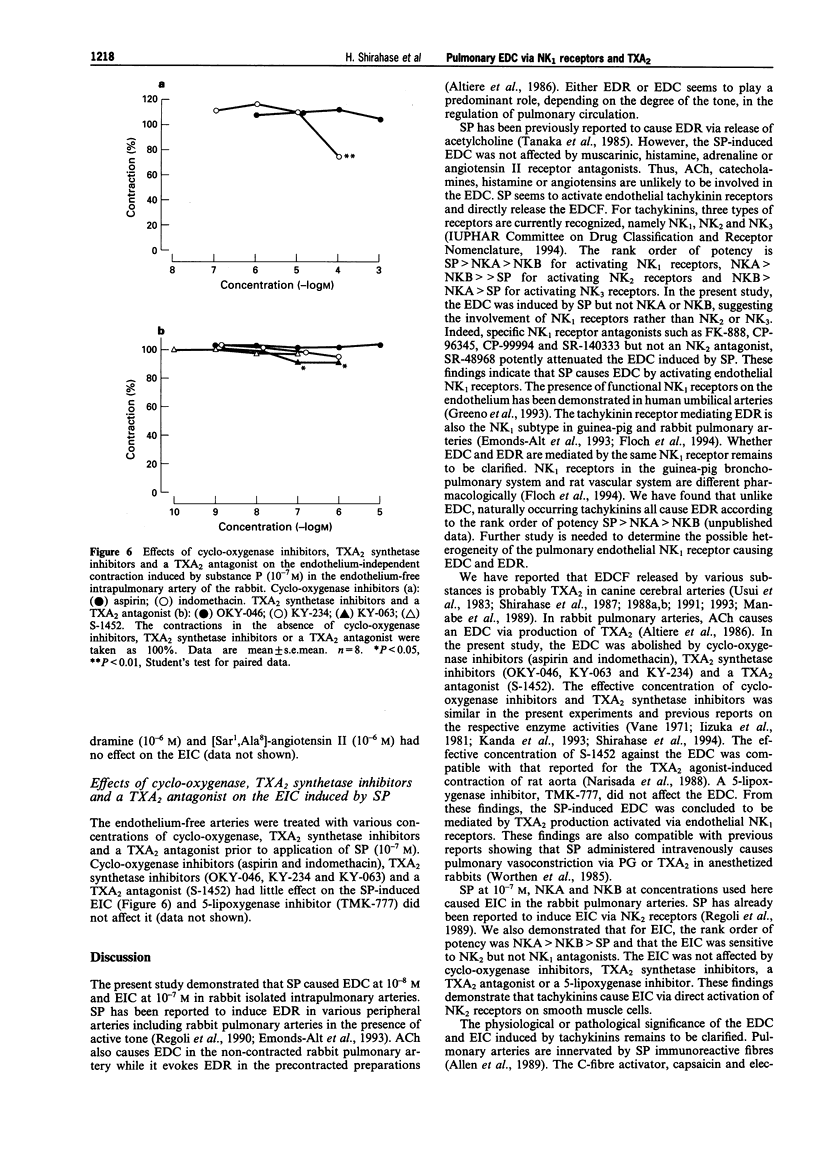
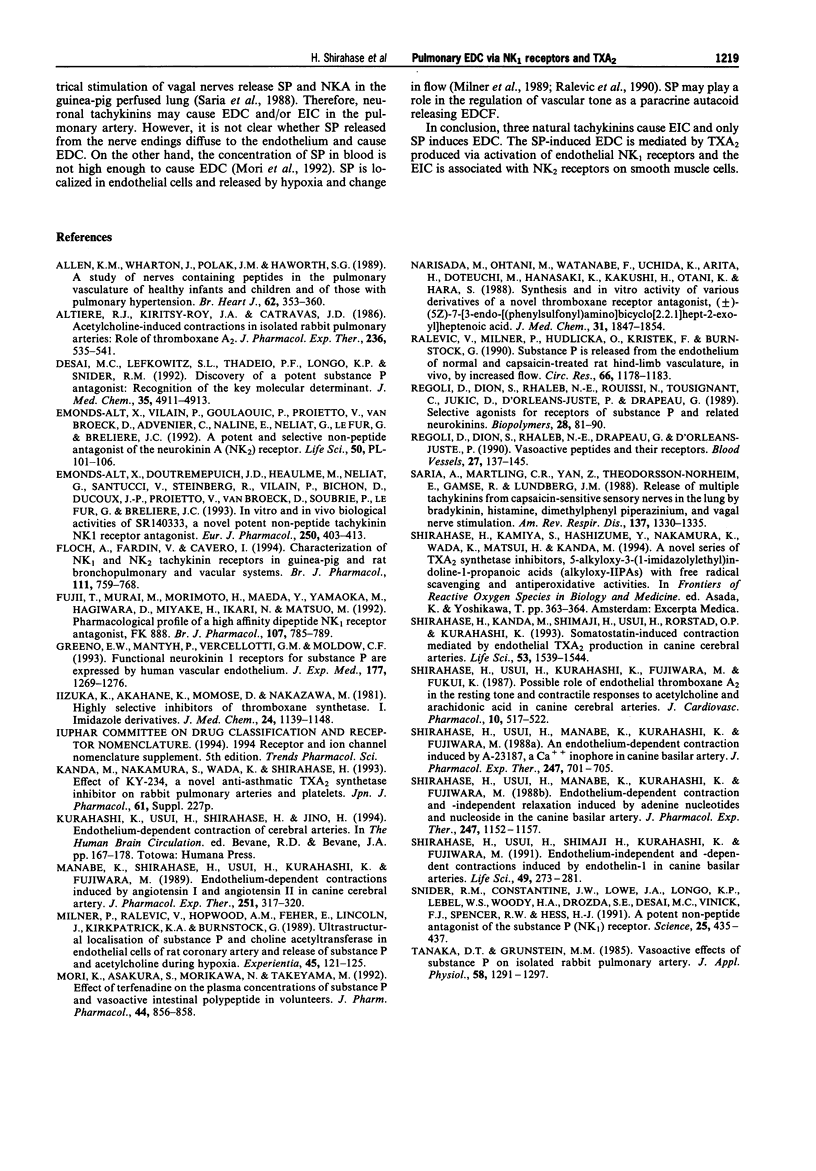
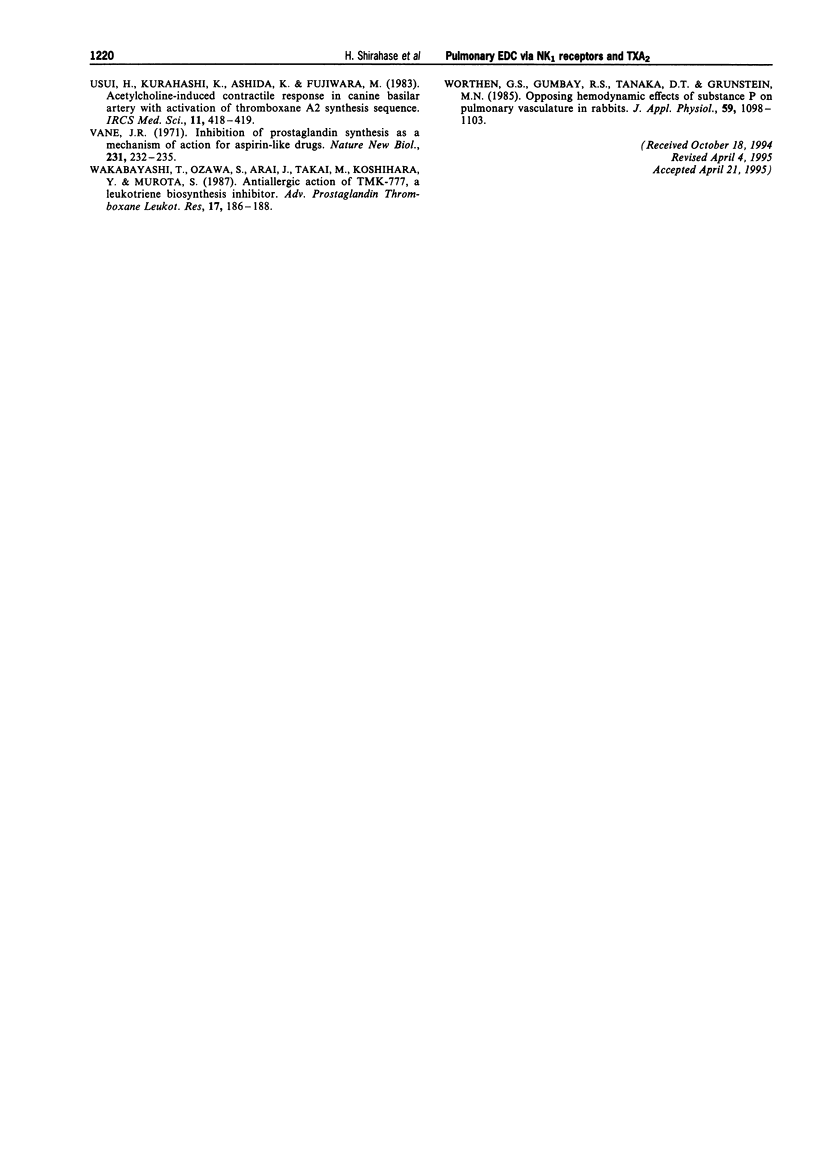
Selected References
These references are in PubMed. This may not be the complete list of references from this article.
- Allen K. M., Wharton J., Polak J. M., Haworth S. G. A study of nerves containing peptides in the pulmonary vasculature of healthy infants and children and of those with pulmonary hypertension. Br Heart J. 1989 Nov;62(5):353–360. doi: 10.1136/hrt.62.5.353. [DOI] [PMC free article] [PubMed] [Google Scholar]
- Altiere R. J., Kiritsy-Roy J. A., Catravas J. D. Acetylcholine-induced contractions in isolated rabbit pulmonary arteries: role of thromboxane A2. J Pharmacol Exp Ther. 1986 Feb;236(2):535–541. [PubMed] [Google Scholar]
- Desai M. C., Lefkowitz S. L., Thadeio P. F., Longo K. P., Snider R. M. Discovery of a potent substance P antagonist: recognition of the key molecular determinant. J Med Chem. 1992 Dec 25;35(26):4911–4913. doi: 10.1021/jm00104a018. [DOI] [PubMed] [Google Scholar]
- Emonds-Alt X., Doutremepuich J. D., Heaulme M., Neliat G., Santucci V., Steinberg R., Vilain P., Bichon D., Ducoux J. P., Proietto V. In vitro and in vivo biological activities of SR140333, a novel potent non-peptide tachykinin NK1 receptor antagonist. Eur J Pharmacol. 1993 Dec 21;250(3):403–413. doi: 10.1016/0014-2999(93)90027-f. [DOI] [PubMed] [Google Scholar]
- Floch A., Fardin V., Cavero I. Characterization of NK1 and NK2 tachykinin receptors in guinea-pig and rat bronchopulmonary and vascular systems. Br J Pharmacol. 1994 Mar;111(3):759–768. doi: 10.1111/j.1476-5381.1994.tb14803.x. [DOI] [PMC free article] [PubMed] [Google Scholar]
- Fujii T., Murai M., Morimoto H., Maeda Y., Yamaoka M., Hagiwara D., Miyake H., Ikari N., Matsuo M. Pharmacological profile of a high affinity dipeptide NK1 receptor antagonist, FK888. Br J Pharmacol. 1992 Nov;107(3):785–789. doi: 10.1111/j.1476-5381.1992.tb14524.x. [DOI] [PMC free article] [PubMed] [Google Scholar]
- Greeno E. W., Mantyh P., Vercellotti G. M., Moldow C. F. Functional neurokinin 1 receptors for substance P are expressed by human vascular endothelium. J Exp Med. 1993 May 1;177(5):1269–1276. doi: 10.1084/jem.177.5.1269. [DOI] [PMC free article] [PubMed] [Google Scholar]
- Iizuka K., Akahane K., Momose D., Nakazawa M., Tanouchi T., Kawamura M., Ohyama I., Kajiwara I., Iguchi Y., Okada T. Highly selective inhibitors of thromboxane synthetase. 1. Imidazole derivatives. J Med Chem. 1981 Oct;24(10):1139–1148. doi: 10.1021/jm00142a005. [DOI] [PubMed] [Google Scholar]
- Manabe K., Shirahase H., Usui H., Kurahashi K., Fujiwara M. Endothelium-dependent contractions induced by angiotensin I and angiotensin II in canine cerebral artery. J Pharmacol Exp Ther. 1989 Oct;251(1):317–320. [PubMed] [Google Scholar]
- Milner P., Ralevic V., Hopwood A. M., Fehér E., Lincoln J., Kirkpatrick K. A., Burnstock G. Ultrastructural localisation of substance P and choline acetyltransferase in endothelial cells of rat coronary artery and release of substance P and acetylcholine during hypoxia. Experientia. 1989 Feb 15;45(2):121–125. doi: 10.1007/BF01954843. [DOI] [PubMed] [Google Scholar]
- Mori K., Asakura S., Morikawa N., Takeyama M. Effect of terfenadine on the plasma concentrations of substance P and vasoactive intestinal polypeptide in volunteers. J Pharm Pharmacol. 1992 Oct;44(10):856–858. doi: 10.1111/j.2042-7158.1992.tb03219.x. [DOI] [PubMed] [Google Scholar]
- Narisada M., Ohtani M., Watanabe F., Uchida K., Arita H., Doteuchi M., Hanasaki K., Kakushi H., Otani K., Hara S. Synthesis and in vitro activity of various derivatives of a novel thromboxane receptor antagonist, (+/-)-(5Z)-7-[3-endo-[(phenylsulfonyl)amino]bicyclo[2.2.1] hept-2-exo-yl]heptenoic acid. J Med Chem. 1988 Sep;31(9):1847–1854. doi: 10.1021/jm00117a028. [DOI] [PubMed] [Google Scholar]
- Ralevic V., Milner P., Hudlická O., Kristek F., Burnstock G. Substance P is released from the endothelium of normal and capsaicin-treated rat hind-limb vasculature, in vivo, by increased flow. Circ Res. 1990 May;66(5):1178–1183. doi: 10.1161/01.res.66.5.1178. [DOI] [PubMed] [Google Scholar]
- Regoli D., Dion S., Rhaleb N. E., Drapeau G., D'Orléans-Juste P. Vasoactive peptides and their receptors. Blood Vessels. 1990;27(2-5):137–145. doi: 10.1159/000158804. [DOI] [PubMed] [Google Scholar]
- Regoli D., Dion S., Rhaleb N. E., Rouissi N., Tousignant C., Jukic D., D'Orleans-Juste P., Drapeau G. Selective agonists for receptors of substance P and related neurokinins. Biopolymers. 1989 Jan;28(1):81–90. doi: 10.1002/bip.360280111. [DOI] [PubMed] [Google Scholar]
- Saria A., Martling C. R., Yan Z., Theodorsson-Norheim E., Gamse R., Lundberg J. M. Release of multiple tachykinins from capsaicin-sensitive sensory nerves in the lung by bradykinin, histamine, dimethylphenyl piperazinium, and vagal nerve stimulation. Am Rev Respir Dis. 1988 Jun;137(6):1330–1335. doi: 10.1164/ajrccm/137.6.1330. [DOI] [PubMed] [Google Scholar]
- Shirahase H., Kanda M., Shimaji H., Usui H., Rorstad O. P., Kurahashi K. Somatostatin-induced contraction mediated by endothelial TXA2 production in canine cerebral arteries. Life Sci. 1993;53(20):1539–1544. doi: 10.1016/0024-3205(93)90562-h. [DOI] [PubMed] [Google Scholar]
- Shirahase H., Usui H., Kurahashi K., Fujiwara M., Fukui K. Possible role of endothelial thromboxane A2 in the resting tone and contractile responses to acetylcholine and arachidonic acid in canine cerebral arteries. J Cardiovasc Pharmacol. 1987 Nov;10(5):517–522. doi: 10.1097/00005344-198711000-00004. [DOI] [PubMed] [Google Scholar]
- Shirahase H., Usui H., Manabe K., Kurahashi K., Fujiwara M. An endothelium-dependent contraction induced by A-23187, a Ca++ ionophore in canine basilar artery. J Pharmacol Exp Ther. 1988 Nov;247(2):701–705. [PubMed] [Google Scholar]
- Shirahase H., Usui H., Manabe K., Kurahashi K., Fujiwara M. Endothelium-dependent contraction and -independent relaxation induced by adenine nucleotides and nucleoside in the canine basilar artery. J Pharmacol Exp Ther. 1988 Dec;247(3):1152–1157. [PubMed] [Google Scholar]
- Shirahase H., Usui H., Shimaji H., Kurahashi K., Fujiwara M. Endothelium-independent and -dependent contractions induced by endothelin-1 in canine basilar arteries. Life Sci. 1991;49(4):273–281. doi: 10.1016/0024-3205(91)90014-3. [DOI] [PubMed] [Google Scholar]
- Snider R. M., Constantine J. W., Lowe J. A., 3rd, Longo K. P., Lebel W. S., Woody H. A., Drozda S. E., Desai M. C., Vinick F. J., Spencer R. W. A potent nonpeptide antagonist of the substance P (NK1) receptor. Science. 1991 Jan 25;251(4992):435–437. doi: 10.1126/science.1703323. [DOI] [PubMed] [Google Scholar]
- Tanaka D. T., Grunstein M. M. Vasoactive effects of substance P on isolated rabbit pulmonary artery. J Appl Physiol (1985) 1985 Apr;58(4):1291–1297. doi: 10.1152/jappl.1985.58.4.1291. [DOI] [PubMed] [Google Scholar]
- Vane J. R. Inhibition of prostaglandin synthesis as a mechanism of action for aspirin-like drugs. Nat New Biol. 1971 Jun 23;231(25):232–235. doi: 10.1038/newbio231232a0. [DOI] [PubMed] [Google Scholar]
- Wakabayashi T., Ozawa S., Arai J., Takai M., Koshihara Y., Murota S. Antiallergic action of TMK-777, a leukotriene biosynthesis inhibitor. Adv Prostaglandin Thromboxane Leukot Res. 1987;17A:186–188. [PubMed] [Google Scholar]
- Worthen G. S., Gumbay R. S., Tanaka D. T., Grunstein M. M. Opposing hemodynamic effects of substance P on pulmonary vasculature in rabbits. J Appl Physiol (1985) 1985 Oct;59(4):1098–1103. doi: 10.1152/jappl.1985.59.4.1098. [DOI] [PubMed] [Google Scholar]


